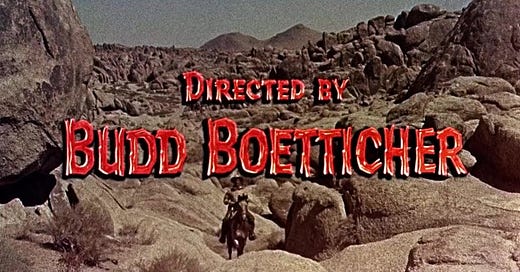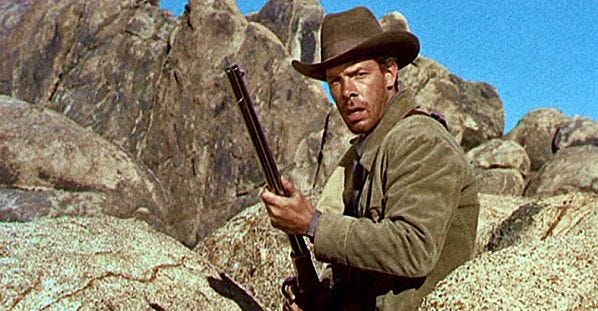Classics of the Week: The Ranown Westerns
Six elegant, elemental variations on the theme of a lone rider
The Nut Graf: The six Budd Boetticher/Randolph Scott Westerns that are leaving the Criterion Channel in a few days (but are still available elsewhere) are A-level B movies: Taut, mature, intensely satisfying.
There’s a ton of great stuff leaving The Criterion Channel on October 31 – all the movies in the Jean Harlow festival, the John Huston spotlight, and especially the cycle of six Randolph Scott Westerns directed by Budd Boetticher from 1956 to 1960 and collectively known as “the Ranown Westerns” after the name of Scott’s production company (which in turn came from the first three letters of the star’s name and the last three of co-producer Harry Joe Brown’s). You can still rent the Ranowns on Amazon Prime Video and elsewhere, but because Criterion put them all in one place for a few months, I was finally able to watch them in sequence after hearing about them for years. Deep dives are rarely this satisfying.
We’ve become lackadaisical about the Western in recent decades, as the physical frontier has faded in American culture and the electronic frontier has overwhelmed us. To younger generations it’s more or less a dead genre, its cliches ripe for deconstructing in TV series like “Westworld” and movies like “The Hateful Eight.” The Coen brothers’ “True Grit” (2010) is a glory, though, and I hear good things about “The Harder They Fall,” a revisionist Western starring Idris Elba and Regina King that comes to Netflix next week. Still, it says a lot that most of the better sagebrush sagas of late have been aimed at the art-house specialty market and have made little impact on mainstream moviegoers: “The Homesman” (2014), “Slow West” (2015), “The Sisters Brothers” (2018), “First Cow” (2020). Even Tom Hanks couldn’t make the stolid, honorable “News of the World” (2020) catch fire. Last week’s tragedy on the set of the Alec Baldwin Western, “Rust,” almost seemed like the coup de grace for an entire school of filmmaking.
Classic Westerns, though, can still shock a viewer with their complexities — with the way they use genre as a template for allegories of civilization, imperialism, genocide, and gender. The old oaters could lie about the West and often did, but they could also be more mature than many modern viewers realize, and the six movies in the Boetticher/Scott cycle are nearly perfect examples of the form. Made primarily for Columbia on B-movie budgets and with tight running times – the longest, “Buchanan Rides Alone” (1958), is all of 80 minutes – they mark a halfway point between the epic frontier mythologies of John Ford, Howard Hawks, and John Wayne and the violent dismantling of those myths in the 1960s by Sam Peckinpah, Sergio Leone, and Clint Eastwood. (As critic Jason Bailey points out, however, that transition was itself quite complex.) The Ranown Westerns are taut and elemental, but they tell stories of considerable psychological depth. It matters that Scott was no young cowpoke but a man pushing 60, playing men who are weathered and spent.
All six movies are fine, but “The Tall T” (1957) may be the best place to start. (There’s a seventh Boetticher/Scott collaboration, 1958’s “Westbound,” but it was a Warner Bros. contract obligation for Scott and the director didn’t consider it part of the cycle.) Based on a story by Elmore Leonard, “The Tall T” is a straightforward affair: Scott plays a lone rancher taken hostage along with a newly married couple at a remote stagecoach stop; their captor (Richard Boone of TV’s “Have Gun – Will Travel”) and his gunmen decide to hold the wife (Maureen O’Sullivan) for ransom while the husband tries to cut a side deal. That’s pretty much it, but that’s enough: A battle of wits and nerves between a stoic hero and a sardonic villain, and Boetticher frames the action with sinew and simplicity.
Looked at with the right angle of appreciation, the Ranown Westerns are a consummate exercise in form and variation. Like a Monet cathedral painting or a Bach fugue, each is the same but different. The Scott character is always terse, honest, often bitter, occasionally wrongheaded. His opponents are amiably nasty and played by a gallery of up-and-coming rogues: Lee Marvin in “Seven Men From Now” (1956), a terrific Claude Akins in “Comanche Station” (1960), Lee Van Cleef and James Coburn and Pernell Roberts in “Ride Lonesome” (1959). The female characters realize they’re saddled with useless men and proceed accordingly, the secondary gunmen indulge in unexpectedly poignant philosophical debates. The Native Americans are still depicted as Hollywood Injuns, but there’s a reason they’re out for blood: They’ve been thoroughly screwed over by the white man and the movies make sure we know that.
“Decision At Sundown” (1957) is the weakest — the director thought so too — perhaps because it’s the one that takes place mostly indoors. “Buchanan Rides Alone” is the funniest. All are worthwhile, with widescreen settings of desert plain and rock formation, of sun and wind and sand, that scrape everything down to the basics. The purity of genre when done with intelligence and feeling can be a beautiful thing.
If you enjoyed this edition of Ty Burr’s Watch List, please feel free to share it with friends.
If you’re not a paying subscriber and would like to sign up for additional reviews and to join the discussions, here’s how:
If you’re already a paying subscriber, I thank you for your support.






